Update #2, Tuesday, March 2, 12:49 EST
TAKEAWAY: Sudkurier, published in scenic Konstanz, Germany, launched its new look yesterday to coincide with the use of its brand new Cortina compact waterless newspaper offset presses. We were on board and show you the new look. ALSO: Follow up on Chilean earthquake AND: The iPad and Garcia Media/Joe Zeff Design: ready for the action.
Sudkurier: Berliner format and new color press make for a smash relaunch

Marketing the new product online: Sudkurier is primarily a subscription-based daily
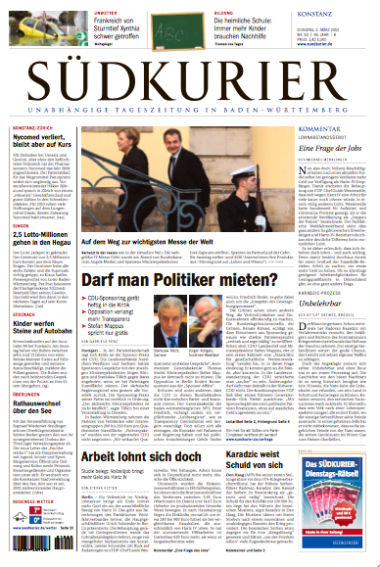
Here is front page of Sudkurier: smaller Berliner format, a classic look inspired by German elegance, order, with a five-column grid
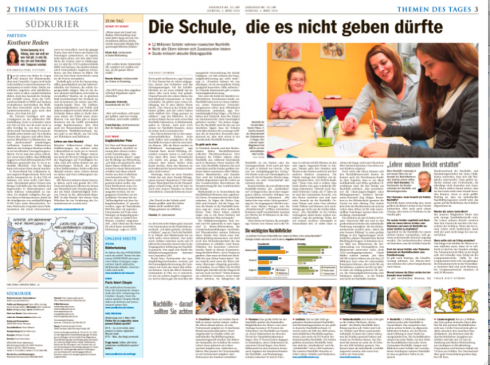
Readers enter a double page 2-3 for the theme of the day, plus some editorial columns
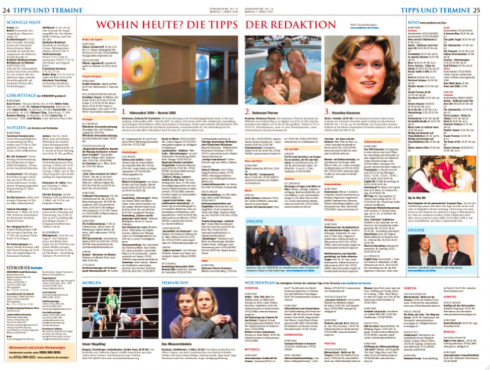
Double page for full listings of what is going on in the various locations. Sudkurier publishes 17 localized editions per day.
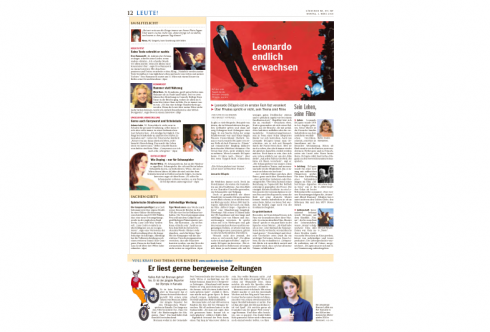
The People page
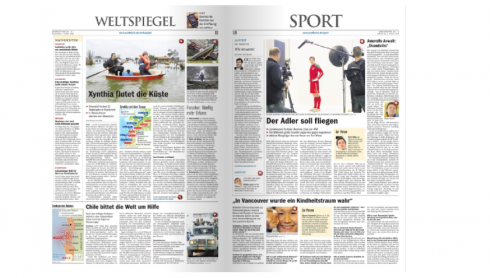
Two inside pages: one about the world’s mirror and one of sport
Once again, Garcia Media had the privilege of working with the Sudkurier team for the past 18 months, leading to the launch yesterday of the newspaper’s new look, now printed with the compact waterless offset press made by Cortina.
Working with our art director, Jan Kny, of Garcia Media Europe, we created several prototypes for the Sudkurier editors and, finally, one was chosen as a favorite in what the editors described as “the one that leads us forward, without losing the support of our very traditional local readers.”
Local is the key word for Sudkurier, which has a loyal following among its 132000 subscribers. The newspaper’s editors produce 17 editions that get localized down to the minor sports of each of these communities situated where Germany meets Switzerland, and with such pretty and scenic locations that extends from Konstanz—-with a lake that extends like the sea and is ideal for running, biking, or just to sit and watch—-to the ever beautiful Black Forest
Format change
Our work included adapting Sudkurier to a smaller Berliner format to be printed on the brand new Cortina offset press (which cost the company around 30 million euros). Who says that newspapers are not investing in their ink/paper future? Cortina, a German firm, is the most diminutive printing press one can imagine, and its makers insist that it is “greener, leaner and more cost-effective”. Indeed, the press is not only waterless, but keyless and gearless, with a unique PlateTronic automatic plate-changing system, which, for a newspaper like Sudkurier, with so many local editions, is exactly what the doctor ordered.
So, the new Sudkurier has color on every page——and good color, too, that equals what one sees on glossy magazines.
New content, too
However, it is not just about a new press, a smaller format and more color. There is new content, too, and a reorganization of how the content flows in Sudkurier.
The newspaper opens with a double page spread, for pages 2 and 3, to cover the “theme of the day.”
In addition, there is the introduction of a new double page for Life and Science, and also a new double page about the agenda for what is going on in the region.
Finally, the new Sudkurier is, as many other newspapers which go through a total rethinking, more about background, analysis, and more local, local, local.
Elements of the new design
The design has also adapted a new font: ITC Franklin from the FontBureau. The logo, however, retains the same font, Trajan, which it has had for 65 years.
Perhaps one of the biggest, and most dramatic changes for Sudkurier: page architecture. Here we have played with a skinny column—-the editors inside call it the “superspalte” or “supercolumn”—-and it cuts through a page like a fine Swiss knife, usually with briefs and secondary details.
A new, softer color palette has been created for infographics, which the new Sudkurier wants to use more often to accompany stories.
Reactions?
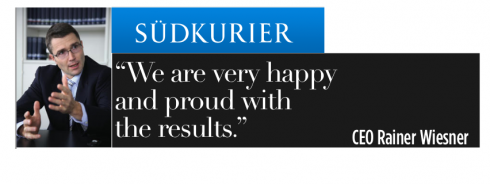
With only two editions out in the streets so far, the reaction, according to the editors, is 99% positive.
Says CEO Rainer Wiesner.:
We are really proud about our results. The new Südkurier is elegant and well organized, but it is also more lively and highly readable. Content
remains at the high journalistic level to which our readers are accustomed. Together, the new packaging, smaller format, bright color, give this Sudkurier a lot to look forward to
This makes me feel good, as I have worked with relaunches of Sudkurier three times, and I am quite aware that the average reader is somewhere in his/her 50s, love their newspaper, take the time to read it, and, well, are not very open to having it changed in anyway.
All throughout the project, our task was to bring in new things while not alienating these very conservative readers. Apparently we have met those goals.
Chile earthquake: follow up
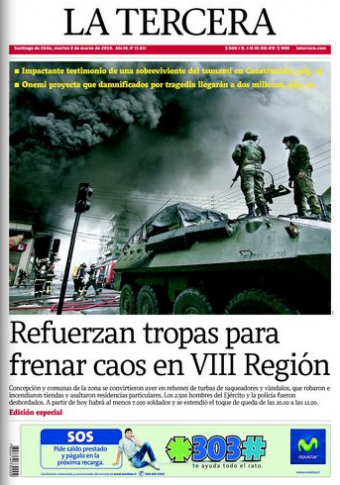
Front page of La Tercera (Santiago) for today
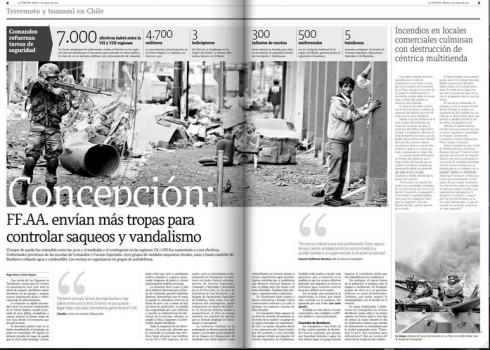
An informative two-page spread from La Tercera: showing a dynamic photo of a soldier stopping a looter in Concepcion, heart of where the earthquake hit
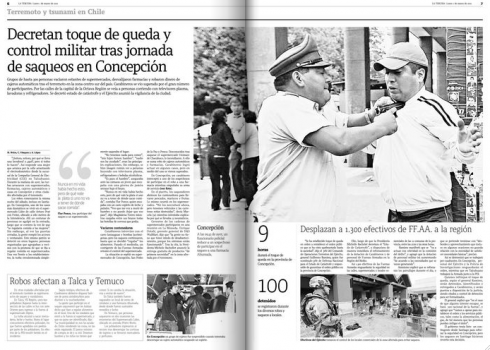
Another great spread: maybe too much white space between headline and text (left), but the impact of the page is great
Javier Devilat, a Chilean designer and my former student at Poynter, continues to update me on the situation in his country following the 8.8 scale earthquake that caused major destruction and over 700 deaths.
The situation is getting ugly here. Many people are looting stores and setting off fires. As police cannot cope with all the chaos, the government has now called for soldiers to come and patrol the streets. People are afraid, since there are occasional aftershocks, and now, all the delinquents out there to have to deal with.
Javier adds that the press has covered the earthquake to the point of saturation, but now turns a bit sensationalistic with its coverage.
Now, for example, they interview a woman who has lost it all. But the note ends there, with her testimony. It does not go further. It does not develop the story from there. For me, at the end of the day, you are left with a feeling of nothingness in your heart, seeing how people are so bad as to steal from those who have nothing, but also to see the courage of people who have lost their family members to the earthquake, and they do it with a sense of acceptance. Then you compare with yourself, who suffered nothing, or very little. The people here need help, Mario, and I hope that the many followers of your blog will hear the message.
I hope so, too, and urge everyone to work through the proper channels for donations, such as the Red Cross.
Two earthquakes, two different sets of numbers

Infographics from Il Secolo XIX compares the earthquake of Haiti with that of Chile
I find the story in Genoa’s Il Secolo XIX about the difference between the Haiti (January) and the Chile earthquakes. Massimo Gentile, design director, had already warned me yesterday that his team was working on a graphic to accentuate “the earthquake of the poor and the earthquake of the richer”.
Today, he has sent me the graphic and how it compares the two earthquakes at various levels. Here is how Massimo explains the graphic in his newspaper:
To compare the facts in the Haiti and Chile earthquakes requires an understanding of why one caused so many casualties, and the other one so much less. We tried to do that through our graphic, highlighting the important things. I think the readers appreciate this type of visual journalism
The major points of comparison, according to this graphic, are:
The Haiti earthquake took place practically in the peripheral area of Port Au Prince, while the Chilean earthquake took place at 400 kilometers from the capital, Santiago.
The difference in the density of population between Chile and Haiti is enormous: more than 600 inhabitants per square kilometer in Haiti, to 22 in Chile.
Then there is the element of standards of living and the prevailing poverty in Haiti, which leads to bad construction standards. Finally, says Massimo, one must take into consideration the depth of the earthquake. The Haiti earthquake was only at 15km, less depth which leads to greater energy as it travels on the surface.
Offering iPad services

As you could see when you first entered our Garcia Media site today, we now are very happy and proud to offer our services to any organization contemplating entering the iPad world for editions of their newspapers, magazines, books, etc. As we are already engaged with clients that are going to be among the first to have an iPad edition, we are aware of the planning that goes into entering the iPad, and we have joined forces with Joe Zeff, of Joe Zeff Design, to form a unique and unparalleled team that is there to help you.
This is new territory for everyone, and the scope of iPad projects cannot compare to that which we are accustomed to, as in the case of a redesign of a newspaper or magazine. Therefore, we feel that we have to offer a variety of programs to those interested in contemplating their iPad future.
As such, one of our programs will be My iPad Baby Steps® , where we guide an organization early on, as it starts thinking of the iPad, but has no concrete plans yet on how to get there.
Of course, then we have the full program offering.
To us, going iPad means planning strategies in five different areas: business strategy (how to monetize it), editorial (storytelling possibilities), user experience strategy (how your audience engages with your brand), technical (how it works), advertising (creating meaningful partnerships with advertisers, exploring new and creative opportunities for advertising). These are the five centerpieces of any iPad project. We at Garcia Media are prepared to assist your organization take steps that will guarantee a smooth iPad launch when you are ready.
Let us hear from you and your plans.
Everyone needs a mentor
This is part 4 of my occasional series 40 Years/40 Lessons, which I call a “sort of career memoir” capturing highlights and reminiscing about what has been a spectacular journey for me, doing what I love most. Today’s segment: Mentors play a key role to help us make it to the finish line
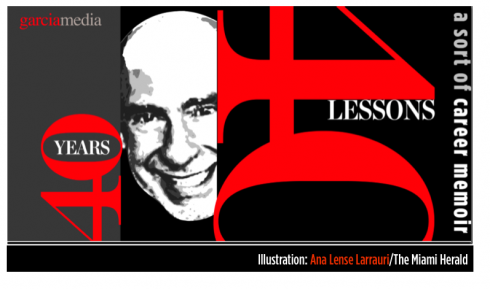

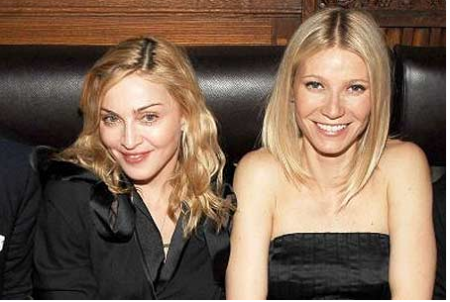
Madonna is mentor to Oscar winning actress Gwyneth Paltrow
I had the best mentors and, perhaps, as a result, I also have had the best mentorees.
I was lucky to encounter mentors in the BPC era. Yes, Before Personal Coaches.
One can now recruit a personal coach, interview several potential candidates then pick the one we wish to assist us to do a job more effectively and/or to progress in our careers.
Personal coaches are now part of the fabric of networking, advancing and beating the competition. In my growing up years, we had no personal coaches as such. Instead, we had mentors.
A mentor would appear without the prerequisite interview.
They were not hired.
There was no transaction, except for that one day when you just knew you had met your mentor. It is hard to tell how you knew you were in the presence of your mentor one fateful day, but you just knew it.
I have to admit that the process was rather informal, highly personal and not as military sounding as it seems to be today, when personal coaches begin by plotting “strategy and tactics” to build up someone’s career.
Mentoring one semester at a time
Maybe we called it differently, although the goals were similar: the mentor would discover you, would then decide that you were worth cultivating to take you as high as your potential—-and your own goals—-could advance you.
As part of “strategy” the good old mentors would hold regular meetings with you, review what progress you had made, and ask about your immediate goals for the next few days or months. The mentors I knew dealt with “semesters”, which seemed more realistic than ” a lifetime.” But all those semesters of mentoring added to lifetime of realizations.
No matter how formal or informal the mentoring process is, everyone needs a mentor.
The first Mentor
The original Mentor is a character in Homer’s epic poem The Odyssey. When Odysseus, King of Ithaca, went to fight in the Trojan War, he entrusted the care of his kingdom to Mentor. Mentor served as the teacher and overseer of Odysseuss’ son, Telemachus.
The Merriam-Webster Dictionary defines a mentor as “a trusted counselor or guide.” For their Mentor/Protégé Program, the Anesthesiology Department of Cleveland’s MetroHealth System defines mentor as “a wise, loyal advisor or coach.”
Wise and loyal. Those are the two key words that best define the mentors I was lucky to have. I refuse to use the word coach to describe any of them.
My first mentor
Her name was Miss Ann Congelo, and she taught English at Miami High. It was my junior year and we were studying American literature, for which I felt passionate from day one. One author after the other opened different avenues and presented me with a variety of different English words, Americanisms and sentence structures that combined to teach me the language, as well as the culture of my new country.
Enter Miss Congelo, who died young.
She was the definition of teacher (aren’t all mentors?). Loved her subject matter, knew it like an expert, and did not count the hours she spent in the classroom, which is why, when I told her that I was interested in reading additional books to the ones assigned in our class list, she looked at me with her big green eyes, smiled, and offered to create a book list for me.
We decided to meet twice a week so I could offer “book reports” and tell her about my readings. Miss Congelo would read Emily Dickinson’s melancholic poetry, stopping to tell me what some of the words meant.
Miss Congelos’ favorite Dickinson poem was “if you were coming in the fall”. When she read it to me, we were the only two people in the room, sitting by her desk, next to those big Miami High School windows, the tall palm trees swaying just outside. I was only 15, but I could tell that Miss Congelo had memorized the words in the poem, and would close her eyes, look away from me, and feel each word of the poem.
No better way to learn English. Without knowing it, I had discovered my first mentor. To this day, every time I use the word “nimble” I remember Miss Congelo, who taught it to me.
I always wondered if Miss Congelo, like Emily Dickinson, had failed to realize her romantic fantasies. I have often thought about it as I re read this poem.
If you were coming in the fall,
I’d brush the summer by
With half a smile and half a spum,
As housewives do a fly.
If I could see you in a year,
I’d wind the months in balls,
And put them each in separate drawers,
Until their time befalls.
If only centuries delayed,
I’d count them on my hand,
Subtracting till my fingers dropped
Into Van Diemen’s land.
If certain, when this life was out,
That yours and mine should be,
I’d toss it yonder like a rind,
And taste eternity.
But now, all ignorant of the length
Of time’s uncertain wing,
It goads me, like the goblin bee,
That will not state its sting.
Of course, Miss Congelo would ask me me to underline words I did not understand. In this poem, a dozen: spum, befalls, Van Dieman’s land,yonder, rind, goads, goblin bee. Miss Congelo will patiently tell me what each word meant, then she would pronounce it slowly, looking at me, making me look at her lips.
First class mentoring from a teacher who died too young. I am happy she was in my life.
Enter Miss G
At Miami-Dade College, I first met my next mentor, Barbara Garfunkel, one hot day in July. It was the summer break but I could not wait to get into the staff of the student newspaper, Falcon Times, and the first step was to meet the advisor. I knew, at the end of that meeting that July 17, 1965 would be a day I would remember. Indeed, at home we had one of those old calendars in our kitchen where you would rip each page off at the end of the day. That night, I saved July 17 in my diary. I knew I had met someone who would make a difference.
Petite, green eyed, and always impeccably dressed in print dresses, and matching custom jewelry, Barbara Garfunkel was the grand dame of journalism education in Miami. Anyone you met at The Miami Herald or The Miami News had been a student of Miss G. She had mentored many, and was proud of it. You mentioned Miss G in the newsrooms around Miami and people smiled, and then proceeded to recount a Miss G anecdote.
Mentors teach.
Mentors mold.
Mentors see in you what you still don’t see in yourself.
They possess special lenses, perhaps, or an antenna that picks up vibes in that person sitting across from them. Whatever it was, Miss G spent two hours with me that first day I met her, explained all about the newspaper, and welcomed me in it. The rest was hard work and discipline, which, by the way, is always the case.
Mentors guide you, mentors don’t give you discipline or do the work for you.
The best mentors demand without making it sound like an order. You simply do not wish to disappoint the mentor, so you try harder. There is nothing wrong with working extra hard not to disappoint, especially if the person you don’t wish to disappoint is yourself.
For Miss G, perfection was the key. I would write my weekly column for the Falcon Times, and she would sit there with me, pushing me to explain a point I had made better, or questioning an assumption not based on facts. I learned tons from Miss G; to this day, I often feel her presence near me when I am writing and see her, pencil in hand, deleting, adding, enhancing the copy.
Then along comes Dr. Sanderson
At the University of South Florida, my mentor quickly became Professor Arthur (Sandy) Sanderson, a Minnesotan who had made Florida home. A short man with a little white hair, he also had a sort of blondish moustache, the result of his constant smoking. In those days, if the professor smoked, he did it in his office.
With Dr. Sanderson, it was first class mentoring, and second hand smoke.
First class mentoring it was. Dr. Sanderson took me under his wing as I became editor of the University’s daily, The Oracle, and he ran the newsroom like it was The New York Times. You had to follow style, meet deadlines, and rewrite, rewrite and rewrite, till all facts were checked three times.
The University of South Florida in 1968 was exploring a medical school (it now has it, and it is nationally recognized), so I was doing weekly stories on the planning stages for the school. I would think I would have it all, return to the newsroom, then Dr. Sanderson,a cigarette forever dangling from the side of his mouth, blue eyes moving from side to side as he read, would take a pencil and cross entire lines out, put question marks here or there, then look at me with a barrage of questions about what I had left out of the story.
“Go back to these two sources, Mario,” he would say in his Midwestern accent. “There is more to the story than you project here. Push those sources. Make them tell you more.”
My defenses would drop. I would feel disarmed. But a power within me would propel me to return to the sources of my story, and to rewrite it, then sit with the patient but demanding professor again. At the end, the story was complete, and my mentor, Dr. Sanderson, would give me praise and incentive.
Mentors do that. They push you hard. They praise you accordingly. To the mentors, you are a teddy bear. Ironically, to the mentorees, the mentors ARE the teddy bears. They make you feel safe and comfortable within your own boundaries.
In Oklahoma, Jim Paschal
I had already graduated, and I was teaching, when I won a Newspaper Fund Fellowship to study at the University of Oklahoma. It was an honor for a college professor to get such a Fellowship, and 12 of us gathered there to study for three weeks, and become better teachers.
That is how I met one of my most theatrically memorable mentors: the late Prof. James F. Paschal. He would become a lifelong friend to me and my family. Jim Paschal taught journalism, but he had a passion for scholastic journalism, student newspapers and yearbooks, and he was certain that participation in student publications made a student a better citizen, regardless of whether they were interested in a journalism career. Of course, after students attended a Jim Paschal workshop, THEY forever wanted to go into journalism. Legions of his students did.
Jim played the piano like a pro, and he loved everything about Walt Disney (had held a job at Disneyland in California during his college years). To this day, when I hear the signature Disney song “When you Wish upon a Star” i immediately think of Jim Paschal and his passion for our profession, his impeccable timing in front of a class (master teacher that he was), and the fact that he was a showman, knew it and did not try to hide it.
Two weeks into the workshop at Oklahoma, Jim pulled me aside one day and said: “You were born to teach, and I think I’d like to join me on a workshop for high school and college journalists next month.”
Showman Jim and showman Mario hit the road to do workshops nationally from coast to coast that summer, and for many years after that.
My mentor Jim taught me that passion is the key and that perfection is not a choice.
I loved that man and what he meant to me, Maria and the children.
Yes, all of my mentors are now deceased. But mentors brand you. Their teachings, guidance, recommendations and, most importantly, their faith in you,, stays there, intact. When you begin to have self doubts, you can see their faces, hear their voices, believing in you. Then, somehow, you straighten yourself up, give them a nod and move on.
Then, suddenly, the constant evolution of life in all its manifestations makes YOU a mentor.
I have mentored many, and I am honored that they would give me the chance. I continue to do that, and will probably do it to the end.
Mentors believe in you and push you to pursue your dreams.
In my view, nobody makes it without that mentor and that push.
The good mentors are happy when the mentorees fly higher than they did.
It happened to Madonna when her mentoree, Gwyneth Paltrow, won the Oscar for best actress.
So, Miss Congelo, Miss G, Dr. Sanderson and Jim Paschal, there would be no 40 Years/40 Lessons without the enormous role that you played in my life.
And, Prof. Paschal, you taught me, in the great Disney tradition, that if you wish upon a star, makes no difference who you are.
I will add that the difference is the mentor you hitch your star to.


1.Mirrors.
https://www.garciamedia.com/blog/articles/40_years_40_lessons_1—a_look_in_the_mirror
2.Refugee.
https://www.garciamedia.com/blog/articles/40_years_40_lessons_2—refugee
3.Teacher..
https://www.garciamedia.com/blog/articles/40_years_40_lessons_3—teacher/
TheMarioBlog post #496